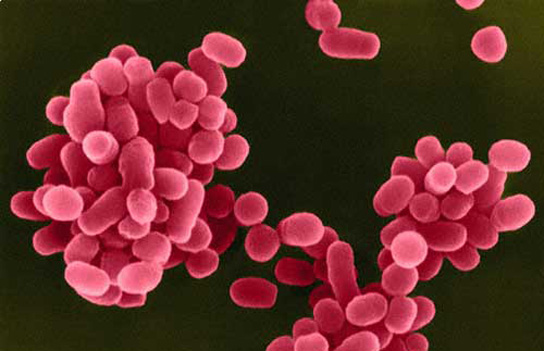
Brucella is a genus of α-Proteobacteria in the family Brucellaceae.
Brucellae are Gram-negative coccobacilli; non-spore-forming and non-motile; aerobic, but may need added CO2. Bacteria of the genus Brucella cause disease primarily in domestic, feral and some wild animals and most are also pathogenic for humans. In animals, Brucellae typically affect the reproductive organs, and abortion is often the only sign of the disorder. Human brucellosis is either an acute febrile disease or a persistent disease with a wide variety of symptoms. It is a true zoonosis in that virtually all human infections are acquired from animals. The disease is controlled by the routine practice of pasteurizing milk and milk products, as well as by comprehensive campaigns to eradicate the disease by destroying domestic animals which exhibit positive serologic reactions to Brucellae.
Structure
Brucellae are Gram-negative coccobacilli (short rods) measuring about 0.6-1.5 μm by 0.5-0.7 μm. They are non-sporing and lack capsules or flagella and, therefore, are non-motile. The outer cell membrane closely resembles that of other Gram-negative bacilli with a dominant lipopolysaccharide (LPS) component and three main groups of proteins. The guanine-plus-cytosine content of the DNA is 55-58 moles/cm. No Brucella species has been found to harbor plasmids naturally although they readily accept broad-host-range plasmids.
The metabolism of the Brucellae is mainly oxidative and they show little action on carbohydrates in conventional media. They are aerobes but some species require an atmosphere with added CO2(5-10 %). Multiplication is slow at the optimum temperature of 37°C and enriched medium is needed to support adequate growth.
Human pathogen
Three species (B melitensis, B abortus, B suis) are important human pathogens; B canis is of lesser importance. Species are differentiated by production of urease and H2S, dye sensitivity, cell wall antigens and phage sensitivity. The major species are divided into multiple biovars. Portals of entry of Brucellae are the mouth, conjunctivae, respiratory tract and abraded skin. Organisms spread, possibly in mononuclear pha gocytes, to reticuloendothelial sites. Small granulomas reveal a mononuclear response; hypersensitivity is a major factor. Effective host defense depends mainly upon cell-mediated immunity.